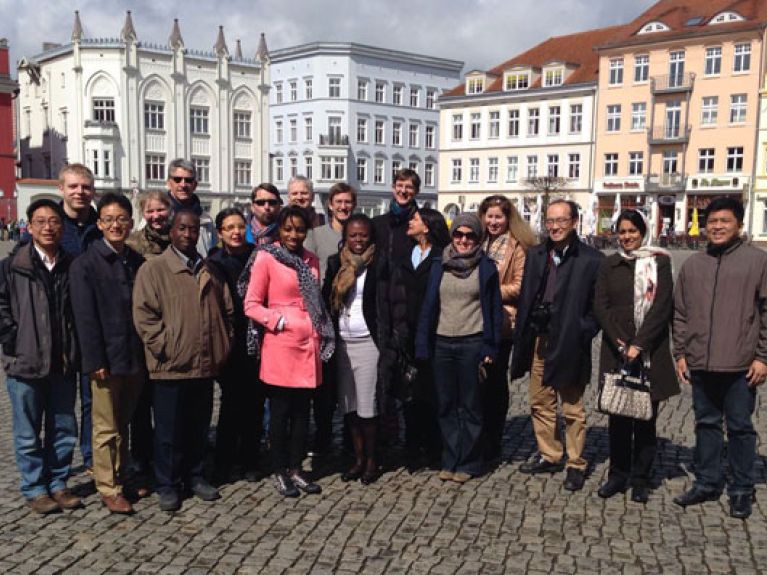International Energy Transition
Out and about with visitors from all over the world, wanting to know how Germany is recalibrating its energy system. In a small town near Greifswald the guests see for themselves just how much determination the Energy Transition requires – and why, nevertheless, it is essential.

The past and future of German energy policy are closely connected on this particular morning. Passing countless wind turbines in the green expanses of the Uckermark, we continue to a decommissioned nuclear power station just outside Greifswald. From the windows of the coach yet another wind park appears, this time a particularly extensive one. Paul Allen Young, who has just been talking about the energy system in his home country of New Zealand, apologizes and reaches for his camera: “Sorry, but this is really impressive.” New Zealand actually relies largely on renewable energies too, which make up around 80 percent of the energy mix, but a large proportion of this comes from hydropower. When it comes to the expansion of other renewable sources, the progress could be faster, Young says.
And that’s the reason why the founder of non-governmental organization “Generation Zero”, which campaigns for the reduction of CO2 emissions, is now in Germany. He wants to understand the political tools that are the driving force behind the Energy Transition here. Together with 16 other journalists, scientists and representatives of NGOs, he has travelled to Germany as part of the Visitors Programme of the Federal Republic of Germany in order to see various locations relevant to the Energy Transition. The occasion for the one-week themed trip, which was organized by the Ecologic Institute, is the 30-year anniversary of the nuclear disaster at Chernobyl. Many participants in the trip come from developing and emerging markets, which are currently having to cover a significantly growing need for energy.
Gathering arguments for debates back home
As is the case in Nigeria. “In my country there is a huge energy and infrastructure deficit”, says Feyisayo Folashade Ajayi, Senior Associate at the Nigerian Economic Summit Group. The NGO is strengthening dialogue between the public and private sectors in the West African country, and as they do so, there is an ever greater focus on how renewable energies can be fostered. “We have a lot of wind and sun; the prerequisites are actually very good,” says Ajayi. Yet because there are no manufacturers of solar and wind power systems in Nigeria, all the technology has to be imported – which makes it entirely unaffordable due to the high customs duties. Ajayi wants to change that, and in Germany she is gathering arguments in her favour. Whilst visiting the Federal Ministry for Economic Affairs and Energy and in discussions with researchers and company representatives, she has already seen the potential regenerative energies have for the labour market. “The investment pays off”, she firmly believes.
A few rows ahead of her on the bus is Syeda Rizwana Hasan from Bangladesh. As far as solar energy is concerned, the environmental lawyer has little to do in her home country – the rapid growth of the economy and the population has led to more new solar systems being installed in Bangladesh than in virtually any other country. But given the enormous need for energy, the government has other plans too: the construction of the country’s very first nuclear power station. Hasan is therefore particularly interested in the destination for this fourth day of the trip, the nuclear power station in Lubmin.
Where the true cost of nuclear energy becomes tangible
The plant on the Baltic Sea was partly put into operation in 1973 and played an important role for electricity provision in the former East Germany. After German reunification in 1990 it was decommissioned – huge investments would have been required to bring it up to a modern level of safety. On the tour the international visitors experience just how expensive decommissioning is. Almost 700 people are currently working on the site. Countless parts have to be disassembled, decontaminated and disposed of. The guests want to know precise details: How much will it all cost – and what was the sum allocated for it? Initially a budget of 4.1 billion euros was available, says Gudrun Oldenburg from Energiewerke Nord. The company, the sole shareholder of which is the German Federal Ministry of Finance, deals with the disposal and interim storage of the fuel assemblies and radioactive waste. “We are currently assuming that costs will total 6.2 billion euros.”
That provides food for thought. “If dealing with atomic waste is such a challenge even for Germany, how are we supposed to manage in Bangladesh?”, asks Syeda Rizwana Hasan. Orsolya Fülöp from Hungary also shows concern. Just like Germany, her homeland will have to tackle the issue of the final disposal of radioactive waste – and at the same time there are plans for the construction of a new nuclear power station. Fülöp is Policy Director of Energiaklub, a “think-and-do tank”, as the she emphasizes. The German Energy Transition fascinates her particularly because it was a “bottom-up” process. It remains a mystery to her though, where the German passion for this transformation and, most significantly, for the nuclear phase-out comes from. “It’s unique the world over.” In a discussion the previous day with Bärbel Höhn, Member of German Parliament for the Greens and Chairwoman of the Committee on the Environment, Nature Conservation, Building and Nuclear Safety, Fülöp was able to grasp this phenomenon a little better, she believes. Now she is hoping for more answers on the following day of the trip, when the group heads to the Wendland to meet representatives of a citizens’ initiative opposing the Gorleben nuclear waste disposal site.
More about the Visitors Programme of the Federal Republic of Germany